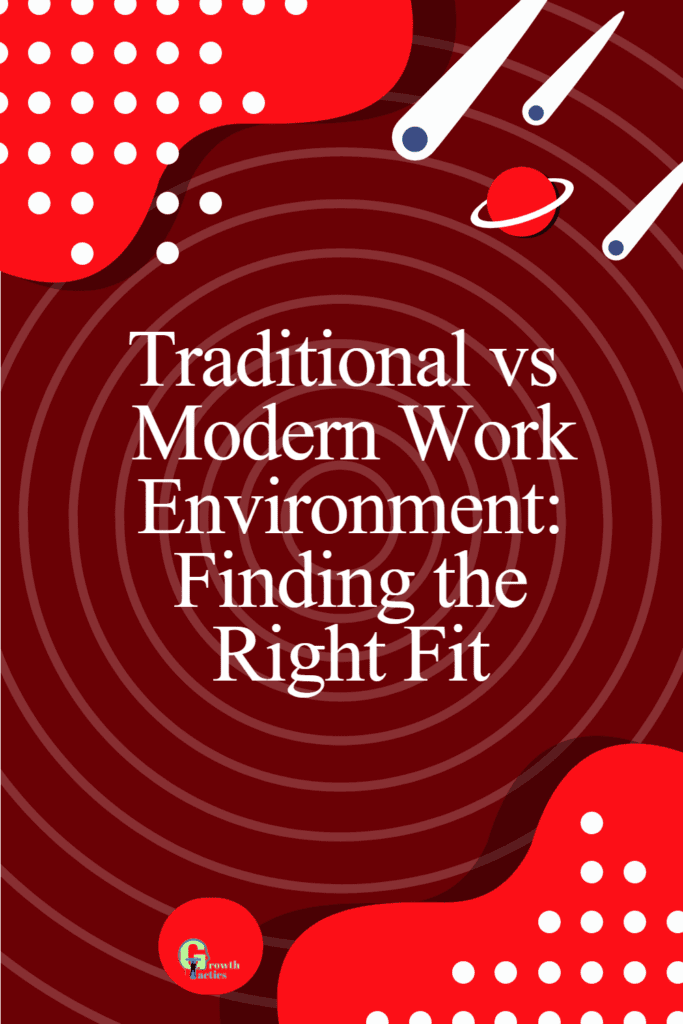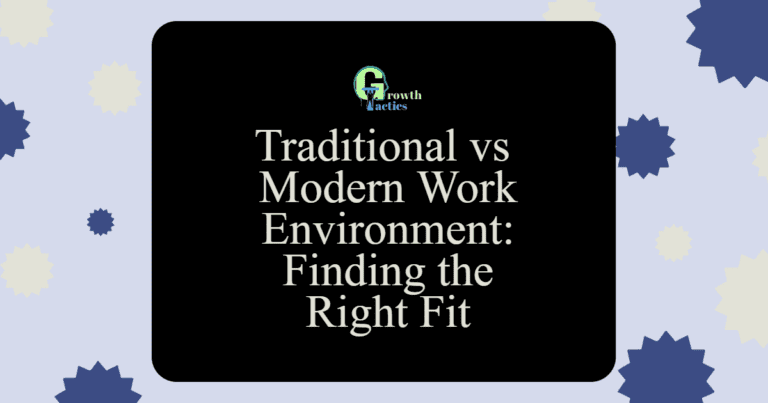In a traditional workplace, the focus is often on hierarchy, fixed roles, and face-to-face communication. Modern workplaces, however, embrace flexibility, collaboration, and technology to empower individuals and foster creativity.
The workplace has evolved greatly over the years, with traditional offices giving way to modern work environments. Today, companies have the option to choose between a more conventional office setup or an innovative design that fosters collaboration and creativity.
The type of work, company values, and employee preferences are all factors to consider when deciding on an office design. In this context, the differences between traditional and modern offices and the impact of office design on productivity and employee satisfaction are worth exploring in more depth.
Jump To Section
Understanding Traditional Work Environments
In the past, traditional work environments were the norm and followed a more structured and hierarchical approach. These workspaces were characterized by individual cubicles or closed offices, with a clear separation between employees.
Characteristics of a Traditional Office Design
When we look at the characteristics of a traditional office design, we see some clear patterns. Here are the key points:
- Physical Barriers: There are physical barriers like walls or partitions between workspaces. This can limit interaction.
- Personal Workspaces: Each person usually has their own desk and either a cubicle or private office.
- Organized Layout: Workspaces are lined up in rows or sections. This helps each person feel they have their own space.
- Privacy and Individuality: The way it’s set up gives a sense of privacy and individuality to each employee.
- Formal Atmosphere: The overall layout tends to be more formal and quiet.
Advantages and Disadvantages of a Traditional Work Environment
One advantage of a traditional work environment is that it offers employees a sense of privacy and personal space. This can be beneficial for focused work tasks that require concentration or confidentiality. Additionally, the physical barriers between employees can reduce distractions and interruptions.
However, there are also drawbacks to traditional work environments. The lack of collaboration and communication opportunities can hinder teamwork and innovation. The rigid hierarchy and separation of employees may limit interactions and impede the flow of ideas. Moreover, the closed-off nature of traditional offices can create a sense of isolation and hinder employee morale.
Case Studies or Examples of Organizations with Traditional Office Layouts
Several well-established companies still adhere to a traditional office layout. For instance, many financial institutions or law firms often maintain a traditional work environment to ensure privacy and confidentiality. These organizations prioritize individual workspaces and value the stability and formality that come with a traditional office design.
By understanding the characteristics, advantages, and disadvantages of a traditional work environment, organizations can better evaluate whether this type of office layout aligns with their company culture, goals, and employee needs.
Understanding Modern Work Environments
With the changing dynamics of the modern workforce, traditional office setups have given way to more innovative and flexible work environments. Modern work environments aim to foster collaboration, creativity, and employee engagement through thoughtful design and technology integration.
Characteristics of a Modern Office Design
Let’s break down the features of a modern office design, focusing on how it supports both individual and collective growth:
- Shared Spaces: Areas like breakout zones and communal spots invite collaboration. They make it easy for people to share ideas and connect.
- Open Floor Plan: Modern offices favor an open floor plan. This design allows people to move freely and choose where they work best.
- Flexible Workspaces: Flexibility is key. You can find the spot that fits your task, whether it’s a quiet corner or a lively, shared table.
- Natural Light: Prioritizing natural light makes the space feel brighter and helps everyone stay more alert and positive.
- Ergonomic Furniture: Modern offices use furniture that cares for your body, promoting comfort and health.
- Aesthetic Design Elements: Thoughtful design isn’t just pretty, it’s functional. It creates an inviting space where ideas can thrive.
Advantages and Disadvantages of a Modern Work Environment
One of the main advantages of a modern work environment is the promotion of collaboration and teamwork. The open layout and shared spaces facilitate communication and foster a sense of community among employees. The availability of flexible workspaces also allows for adaptability and encourages creativity.
However, it’s important to note that modern work environments may not suit every individual or work style. Some employees may find the open layout distracting or prefer more privacy. Additionally, the increased noise levels in an open office may require effective noise management strategies to ensure productivity.
Case Studies or Examples of Organizations with Modern Office Layouts
Many tech companies, startups, and creative agencies have embraced the modern work environment. For example, companies like Google and Facebook are well-known for their open office layouts and innovative design elements that promote collaboration, creativity, and employee well-being.
By considering the characteristics, advantages, and potential disadvantages of a modern work environment, organizations can determine if this type of office design aligns with their company culture, goals, and the preferences of their workforce.
Comparing Traditional and Modern Offices
As companies explore different office design options, it’s useful to evaluate the differences between traditional and modern offices. While traditional offices emphasize individual workspaces, formal communication, and privacy, modern offices prioritize shared spaces, collaboration, and flexibility.
Differences in Layout
Traditional offices are characterized by individual workspaces separated by physical barriers, such as cubicles or private offices. These spaces are usually arranged in a linear fashion, creating a more rigid and formal environment. In contrast, modern offices feature an open floor plan with a variety of flexible workspaces, such as standing desks, communal tables, and breakout areas.
Differences in Communication
Traditional offices tend to have more formal and structured communication channels, such as phone calls or emails. Employees often work in isolation or have limited interaction opportunities. In a modern office, communication is encouraged and facilitated through shared spaces and collaboration tools. Employees are encouraged to interact, share ideas, and work together to solve problems.
Differences in Design Elements
Traditional office design prioritizes consistency, privacy, and formality. Aesthetically, these designs feature muted colors and standardized furniture. Modern offices value creativity and individuality and often feature bold design elements, such as colorful accent walls, unique lighting fixtures, and unconventional furniture.
By understanding the differences between traditional and modern offices, companies can evaluate which office design style best aligns with their company culture, work style, and employee needs.
Assessing the Right Fit: Matching Work Environment to Company Culture and Employee Needs
When it comes to designing a work environment, it’s crucial for organizations to consider the alignment between their company culture and the needs of their employees. Understanding both aspects can help create a workspace that fosters productivity, engagement, and overall satisfaction among employees.
Evaluating Company Culture
Before deciding on a specific work environment, organizations should assess their company culture. This involves understanding the values, beliefs, and behaviors that define the company. Is the culture more traditional, emphasizing structure and privacy? Or is it modern, promoting collaboration and flexibility?
Evaluating company culture can help determine the desired atmosphere and layout for the workspace. It ensures that the work environment reflects the company’s identity, promotes its core values, and supports employees in their work.
Understanding Employee Needs
To create a work environment that caters to employee needs, organizations need to understand the preferences and requirements of their workforce. This involves actively engaging with employees through surveys, interviews, or focus groups, and considering factors such as work style, communication preferences, and physical comfort.
Some employees may thrive in open, collaborative spaces with a constant buzz of activity, while others may require more quiet and privacy to concentrate. By considering employee needs, organizations can design a workspace that supports different work styles, promotes well-being, and enhances productivity.
Finding the Right Balance
Matching the work environment to company culture and employee needs requires finding the right balance. It’s essential to identify common elements that align with both the company’s values and the employees’ requirements.
For example, a company with a modern and innovative culture can still offer private spaces or quiet rooms for employees who need focused work time. In contrast, a traditionally structured company can introduce collaborative areas or flexible workstations to foster teamwork and employee engagement.
Continual Assessment and Adaptation
Creating a work environment that aligns with company culture and employee needs is an ongoing process. As businesses and employee expectations evolve, it’s crucial to continually assess the workspace and make necessary adaptations.
Regular feedback collection from employees, observation of work patterns, and staying updated on industry trends can guide organizations in making informed decisions about changes or improvements to the work environment.
By prioritizing the match between company culture and employee needs, organizations can create a work environment that supports their employees, enhances productivity, and contributes to overall success.
Seeking Professional Guidance for Office Redesign or Relocation
Redesigning or relocating an office can be a complex and daunting task. To ensure a successful outcome, it’s often beneficial to seek the guidance of a professional who specializes in workspace planning and design. Here are some reasons why:
Expertise and Insight
Professional workspace planners and designers offer expertise and insight that may not be available within an organization. A professional can assess the company’s needs, evaluate the space, and offer solutions that best suit the organization’s goals, culture, and workforce.
A workspace planner can also identify industry trends or innovative design elements that can enhance the company’s workspace. Their experience with various organizations and types of workspaces can provide valuable insights into what works best for different contexts.
Comprehensive Planning and Execution
Redesigning or relocating an office involves several complex steps, from evaluating the current workspace, selecting a new location, defining the space program, and designing and executing the final plan. A professional workspace planner can manage this entire process, ensuring smooth and efficient transition and execution.
From project management to construction coordination, a professional workspace planner can provide a comprehensive solution that takes care of all details while minimizing the impact on the company’s daily operations.
Improved Employee Satisfaction
A workspace that is thoughtfully designed and aligned with the company’s culture and employee needs can have a significant impact on employee satisfaction and productivity. A professional workspace planner can create a workspace that not only meets the company’s functional requirements but also enhances employee comfort, engagement, and well-being.
By involving employees in the design process and prioritizing their needs, professional workspace planners can create a workspace that fosters collaboration, creativity, and overall job satisfaction.
Case Studies or Examples of Successful Workspace Planning and Design
Many successful organizations have benefited from professional workspace planning and design. For example, when Dropbox decided to relocate their San Francisco headquarters, they enlisted the help of professional workspace planning firm Gensler to create a space that encourages collaboration and innovation. The result was a vibrant and flexible space that promoted employee well-being and helped drive company growth.
By seeking the guidance of a professional workspace planner, companies can create a workspace that aligns with their culture, supports their employees, and contributes to overall success.
Wrapping It Up
In conclusion, creating a workspace that matches company culture and employee needs is crucial for fostering employee engagement, productivity, and overall well-being.
By prioritizing the match between company culture and employee needs, organizations can create a workspace that supports their employees, enhances productivity, and contributes to overall success.


